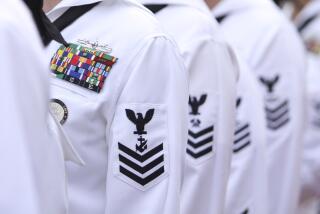Pentagon Office Questions Value of DIVAD Gun Tests
- Share via
WASHINGTON — The Pentagon’s chief weapons tester has raised questions about the value of tests intended to determine the future of the controversial Sgt. York (DIVAD) anti-aircraft gun, stating that a set of key trials was conducted under “significant” limits.
“Extensive efforts were expended” in “live fire” tests in which the DIVAD, or Division Air Defense, gun was fired in June at target aircraft at the White Sands Missile Range in New Mexico, the official, John E. Krings, wrote in a letter to a leading congressional critic of the weapon.
But “a valid assessment of the potential contribution (of the live fire tests) to a fair evaluation (of the gun) shows the limitations were and still are significant,” wrote Krings, the new director of the Office of Operational Test and Evaluation, to Rep. Denny Smith (R-Ore.).
He said concerns raised by Smith over the performance of the DIVAD are valid. But he added that the tests’ “imperfections” could be taken into consideration when their results are presented to Pentagon officials.
Krings said the target aircraft--unmanned, remote-controlled F-100 fighters and Huey helicopters--could neither maneuver nor hover and thus did not imitate the performance of the Soviet aircraft that would be the DIVAD’s battlefield targets.
One Pentagon official, speaking on condition that he not be identified, acknowledged that the targets were “not representative of the real threat.”
“There were some very severe limitations on the live fire, and we knew that,” this official acknowledged.
The tests were ordered by Defense Secretary Caspar W. Weinberger, who must decide by the end of this month whether to proceed with the Army’s purchase of the DIVAD. So far, the Army has spent $1.5 billion for 146 of the weapons, whose accuracy and ability to function under battlefield conditions have been repeatedly questioned. A total of 50 DIVADs have been delivered.
The Army is seeking to buy another 117 guns for $417.5 million, and Weinberger’s approval, based on the latest round of tests, is needed. Earlier, the defense secretary had put the purchase on hold pending the new evaluation.
Three separate tests have been completed, according to the Army, and the data are being sent to Weinberger, who is expected to be briefed on the test results Aug. 23. Krings is filing a report independent of the Army, which has been pressing Weinberger to approve the weapon.
Rep. Smith, meanwhile, has questioned whether reports of the tests present a full picture of the weapon’s performance. He also has criticized the presence of representatives of the weapons’ producer, Ford Aerospace & Communications Corp. of Newport Beach, at the tests.
But Krings cautioned in an interview that the ability of company employees “to do anything to the data was practically zero.”
Ford Aerospace has asserted that, during the tests, the weapon destroyed “six of seven high-performance aircraft and three of three helicopters.” Smith, however, said in a letter to Krings that an Army videotape of the tests shows that “far more than 18 passes or ‘target presentations’ against the Sgt. York were made.”
Two DIVADs were used in each test, he said, while in several tests, two F-100s were flown--in effect quadrupling the number of opportunities that the DIVAD had to strike a target.
“While both the Army and Ford Aerospace are advertising that the Sgt. York was successful in downing six of seven fixed-wing targets, I will be most interested to learn just how many target presentations were required to achieve this number,” Smith wrote to Krings. “From all appearances, it looks as though there were many.”
The congressman also charged that the 40-millimeter proximity ammunition fired at the airborne drones was inadequate to destroy an aircraft .
More to Read
Sign up for Essential California
The most important California stories and recommendations in your inbox every morning.
You may occasionally receive promotional content from the Los Angeles Times.













